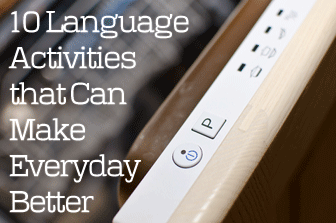10 Language Activities that Can Make Everyday Better


My ESL students, no matter what classes they were taking, were studying to learn a language. After about five minutes (I may be exaggerating, but it didn’t take long) I learned that although these students were learning the same language, they weren’t the same. My business students wanted practical language skills, real life application, and career specific vocabulary and language tasks. When they got these, they flourished. When they didn’t, they were frustrated. They often didn’t have time for extensive homework, and they appreciated when homework directly applied to their work lives. When students are interested in and value what they are learning, they do better. That’s just one of the reasons I think it’s beneficial to teach business specific English in business English classes even when you are teaching the basics of the language. One of those basics is the use of adjectives, comparatives, and superlatives. The following activities are perfect for students of Business English who are learning these basics but still want the things they learn to be practical for the workplace.

Your students may not work in the advertising industry (though if they do this activity will be extremely practical), but part of any good business is generating new business. To do so, companies turn to advertising. Your students can develop some advertising messages of their own while learning and using adjectives. Have students choose a product for which they will write an advertisement. If their company manufactures a particular item, that would be a good choice for the activity. Otherwise, have students choose an item they use on a daily basis or choose a product they wish they owned. Have students make a list of at least ten adjectives that describe that product. You may want to work with your class to list adjectives that are useful in advertising – words like inexpensive, reliable, smart, popular, and economical. Once students have compiled their lists, have them choose one adjective around which to develop an advertisement. Have students write a simple slogan following this pattern: product name, the adjective noun. (For example, the iPhone, the smart smart phone or Lucky Charms, the magical cereal.) Then using this slogan, students should design a one page magazine ad for their product. If you like, compile all the ads into a class ad magazine and make copies for everyone. Ask students which product they like most and why.
For most people working in the business industry, comparing products is not uncommon. They may compare products for purchase, vendors for hire, or candidates for a job opening. Having your students compare products in their work field will give them a chance to practice using comparative adjectives. If possible, bring three or more similar products into your business classroom. For example, if your students work in footwear manufacturing, you might want to bring in three different brands of sneakers. If they work in the electronic entertainment industry, bring in a laptop, a tablet computer and use your classroom desktop computer. Or have students bring in their own examples. Have students work with a partner to compare the different products. They should note differences in the product and write down their observations using comparative adjectives. For example, the laptop is smaller than the desktop. The tablet is smaller than the laptop. The desktop is more permanent than the others. Once students have made comparisons between the products, have them decide which are superlative. Students should choose the product they think is best and then write a few sentences recommending that product to their company for purchase using a superlative and several adjectives. Their simple recommendations might look something like the following: Cola A is the best drink. It is sweet. It tastes good. It is inexpensive.
Numbers and statistics are helpful information. They help businesses know what is working and what isn’t. But throwing a bunch of numbers on a page isn’t good business, and it doesn’t communicate with the impact of graphs and charts. Visual aids like bar graphs, pie charts, and line graphs all communicate numeric facts in a visual way, and the language barrier doesn’t inhibit your students from understanding them. You can use these types of graphics with your ESL students to give them practice using comparative and superlative adjectives. Start by making copies of sales graphs for each of your students. (You can find sample graphs here or make your own.) Then have groups of two or three students work together to make comparisons between the products listed in the tables. Remind students that adjectives of two or fewer syllables generally take the suffix –er to form a comparative adjective while those with three or more syllables use the pattern more + adj for comparisons. You might also want to brainstorm a list of adjectives that can express how valuable profit savvy a product is (good, bad, lucrative, expensive, popular, etc.). Students should look at the graphs and formulate comparative sentences either in writing or orally with a partner. For example, Product 1 is more popular than product 5. Product 6 is worse than product 2. And so on. After students have come up with some simple sentences, show them how to make direct comparisons between two products using the following phrase: When you compare A with B… Students can then rephrase their comparative sentences using this expression. (When you compare product 1 with product 5, product 1 is more popular.)
Whether your students are applying for jobs or trying to fill them, interviews are a regular part of the business world. Interviews give applicants a chance to point out their strengths and argue why they would be valuable employees. You can have students prepare for their next interview by talking through the answers to these mini interview questions. Match students with a partner (or act as the interviewer yourself if you are working one on one) and have them perform the following role play. One person is the employer interviewing for an important position in the company. The other student is a potential employee who is on a first interview. Interviewers should ask these questions: Describe yourself. What are your best qualities? What are your worst qualities? Why are you right for this job? Students should answer questions one at a time using personal adjectives to explain why they are the best person for the job. At the end of the role play, interviewers should let the interviewee know whether or not he got the job. The students then switch roles and repeat the interview.
These activities will enable them to practice adjectives in real life business scenarios and will give them language skills they can take directly to the boardroom.
Do you teach business English students? What types of business specific activities do you do with them? Please share them in the comments below.